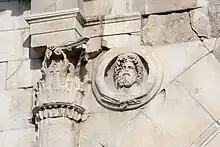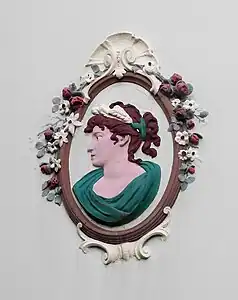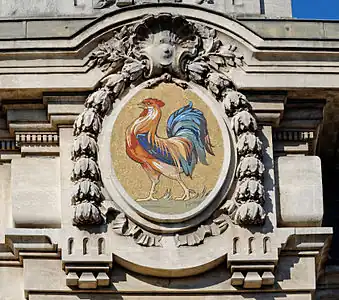Medallion (architecture)
A medallion is a round or oval ornament[1] that frames a sculptural or pictorial decoration in any context, but typically a façade, an interior, a monument, or a piece of furniture or equipment.

Ancient Roman round versions are called an imago clipeata, from the clipeus or Roman round shield.
This was a popular form of decoration in neoclassical architecture. The frame and portrait were carved as one, in marble for interiors, and in stone for exterior walls.
It is also the name of a scene that is inset into a larger stained glass window.
Gallery
The following gallery shows how medallions changed over time, from style to style, and how decorated or simple they were. Sometimes they were one of the key ornaments of a style, like the Louis XVI style of the 18th century and the Beaux Arts architecture of the Belle Époque. They also came in different shapes, not just circles and ovals. Many Art Deco medallions are octagonal, showing the use of angular and stylized shapes that characterize the style, inspired by Cubism. They also had different reliefs inside over time. For example, some medieval Moldavian churches are decorated with colourful medallions that feature animals and mythological creatures, while many oval Neoclassical ones feature profiles, inspired by Roman cameos.
_(2).jpg.webp) Roman shell-shaped medallion on a sarcophagus of a married couple, early 4th century, marble, Musée de l'Arles antique, Arles, France[2]
Roman shell-shaped medallion on a sarcophagus of a married couple, early 4th century, marble, Musée de l'Arles antique, Arles, France[2] Byzantine mosaic medallion with the Chi Rho on the ceiling of Baptistery of San Giovanni in Fonte, Naples, Italy, unknown architect or craftsman, 362-408[3]
Byzantine mosaic medallion with the Chi Rho on the ceiling of Baptistery of San Giovanni in Fonte, Naples, Italy, unknown architect or craftsman, 362-408[3] Byzantine mosaic medallions with rinceaux in the Cappella Palatina, Palermo, Italy, unknown architect or craftsman, 1140s[4]
Byzantine mosaic medallions with rinceaux in the Cappella Palatina, Palermo, Italy, unknown architect or craftsman, 1140s[4] Byzantine medallions on the cover of the Melisende Psalter: Works of Mercy, 1131-1143, ivory, British Library, London[5]
Byzantine medallions on the cover of the Melisende Psalter: Works of Mercy, 1131-1143, ivory, British Library, London[5]_Real_Monasterio_Entrada_095.jpg.webp)
.jpg.webp) Moldavian style ceramic medallions on the facade of the Saint Nicholas Princely Church, Iași, Romania, c. 1888
Moldavian style ceramic medallions on the facade of the Saint Nicholas Princely Church, Iași, Romania, c. 1888 Moldavian style ceramic medallions on the facade of Biserica Sfântul Nicolae, Bălinești, Romania, unknown architect, 1494-1499
Moldavian style ceramic medallions on the facade of Biserica Sfântul Nicolae, Bălinești, Romania, unknown architect, 1494-1499.jpg.webp) Renaissance medallion-like oculus on the west facade of the Cour Carrée of the Louvre Palace, with figures of war and peace, sculpted by Jean Goujon and designed by Pierre Lescot, 1548[6]
Renaissance medallion-like oculus on the west facade of the Cour Carrée of the Louvre Palace, with figures of war and peace, sculpted by Jean Goujon and designed by Pierre Lescot, 1548[6].jpg.webp) Renaissance medallion with marble plaques on the north facade of the Cour Carrée of the Louvre Palace, designed by Pierre Lescot, 16th century[7]
Renaissance medallion with marble plaques on the north facade of the Cour Carrée of the Louvre Palace, designed by Pierre Lescot, 16th century[7] Louis XIII style medallion painted on some boiserie in the Bibliothèque de l'Arsenal, Paris, unknown architect and painter, c.1610-1643
Louis XIII style medallion painted on some boiserie in the Bibliothèque de l'Arsenal, Paris, unknown architect and painter, c.1610-1643 Wisdom casting out Calumny, Baroque painting by Noël Coypel, c.1656-1666, Palais du Parlement de Bretagne, Rennes, France
Wisdom casting out Calumny, Baroque painting by Noël Coypel, c.1656-1666, Palais du Parlement de Bretagne, Rennes, France Baroque medallion on a ceiling in the high hall of the chapel of the Palace of Versailles, Versailles, France, unknown architect or sculptor, 17th century
Baroque medallion on a ceiling in the high hall of the chapel of the Palace of Versailles, Versailles, France, unknown architect or sculptor, 17th century Baroque sculpture of cherubs holding a medallion with Louis XIV's monogram, unknown sculptor, late 17th-very early 18th century, Palace of Versailles, Versailles, France
Baroque sculpture of cherubs holding a medallion with Louis XIV's monogram, unknown sculptor, late 17th-very early 18th century, Palace of Versailles, Versailles, France
.jpg.webp) Rococo medallion of the Helbling House, Innsbruck, Austria, by Anton Gigl, beginning of the 18th century, finished in 1732
Rococo medallion of the Helbling House, Innsbruck, Austria, by Anton Gigl, beginning of the 18th century, finished in 1732_Palais_des_Ducs_de_Bourgogne_-_Chapelle_des_%C3%89lus_-_47.jpg.webp)
 Louis XVI style medallion a grotesque panel, originally from the Hôtel Grimod de La Reynière, Paris, designed and painted by Charles-Louis Clérissea, 1770s, Victoria and Albert Museum, London
Louis XVI style medallion a grotesque panel, originally from the Hôtel Grimod de La Reynière, Paris, designed and painted by Charles-Louis Clérissea, 1770s, Victoria and Albert Museum, London_MET_DP103172.jpg.webp) Louis XVI style medallion with a portrait relief on a vase with cover, by the Sèvres porcelain factory, c.1778, soft-paste porcelain, Metropolitan Museum of Art, New York
Louis XVI style medallion with a portrait relief on a vase with cover, by the Sèvres porcelain factory, c.1778, soft-paste porcelain, Metropolitan Museum of Art, New York Neoclassical medallions on the handle of the Londonderry Vase, made by the Sèvres Porcelain Manufactory, designed by Charles Percier, decoration designed by Alexandre-Theodore Brogniart, flowers and ornament painted by Gilbert Drouet, and birds painted by Christophe-Ferdinand Caron, 1813, hard-paste porcelain, polychrome enamels, gilding, and gilt bronze mounts, Art Institute of Chicago, US[8]
Neoclassical medallions on the handle of the Londonderry Vase, made by the Sèvres Porcelain Manufactory, designed by Charles Percier, decoration designed by Alexandre-Theodore Brogniart, flowers and ornament painted by Gilbert Drouet, and birds painted by Christophe-Ferdinand Caron, 1813, hard-paste porcelain, polychrome enamels, gilding, and gilt bronze mounts, Art Institute of Chicago, US[8] Neoclassical medallion on the Grave of Geoffroy Saint-Hilaire, Père Lachaise Cemetery, Paris, by David d'Angers, 1844
Neoclassical medallion on the Grave of Geoffroy Saint-Hilaire, Père Lachaise Cemetery, Paris, by David d'Angers, 1844 Renaissance Revival medallion on Cafeneaua Veche, Bucharest, Romania, unknown architect, early 19th century
Renaissance Revival medallion on Cafeneaua Veche, Bucharest, Romania, unknown architect, early 19th century Neoclassical medallion in Le Grand Véfour, Paris, by M.L. Viguet, 1852[9]
Neoclassical medallion in Le Grand Véfour, Paris, by M.L. Viguet, 1852[9] Beaux Arts polychrome medallions on the facade of a building in Montpellier, France, unknown ceramist, mid-to-late 19th century
Beaux Arts polychrome medallions on the facade of a building in Montpellier, France, unknown ceramist, mid-to-late 19th century Neoclassical polychrome medallion on the facade of the Lycée Carnot, Dijon, designed by Arthur Chaudouet, 1885-1893
Neoclassical polychrome medallion on the facade of the Lycée Carnot, Dijon, designed by Arthur Chaudouet, 1885-1893.jpg.webp) Medallion on a Neoclassical stove in the principals' house of the Central Girls' School, Bucharest, unknown designer, 1890
Medallion on a Neoclassical stove in the principals' house of the Central Girls' School, Bucharest, unknown designer, 1890.jpg.webp) Beaux Arts medallions on the 2nd floor meeting room of the Commerce and Industry Chamber Building (Rue Notre-Dame-des-Victoires), Paris, by Juste Lisch, 1891
Beaux Arts medallions on the 2nd floor meeting room of the Commerce and Industry Chamber Building (Rue Notre-Dame-des-Victoires), Paris, by Juste Lisch, 1891 Neoclassical medallion on the facade of Le Moulin de la Vierge (Rue Saint-Dominique no. 64), Paris, by Benits et Fils, c.1900[10]
Neoclassical medallion on the facade of Le Moulin de la Vierge (Rue Saint-Dominique no. 64), Paris, by Benits et Fils, c.1900[10].jpg.webp) Romanian Revival medallion on the Grave of Georgiev Brothers, Bellu Cemetery, Bucharest, by Ion Mincu, c.1900
Romanian Revival medallion on the Grave of Georgiev Brothers, Bellu Cemetery, Bucharest, by Ion Mincu, c.1900 Hexagonal ceramic medallion on the Villa La Sapinière, Évian-les-Bains, France, architect Jean-Camille Formigé and sculptor Alexandre Falguière, 1892-1896
Hexagonal ceramic medallion on the Villa La Sapinière, Évian-les-Bains, France, architect Jean-Camille Formigé and sculptor Alexandre Falguière, 1892-1896 Rococo Revival polychrome medallion on the facade of Beckershoffstraße no. 7, Mettmann, Germany, unknown architect, 1902
Rococo Revival polychrome medallion on the facade of Beckershoffstraße no. 7, Mettmann, Germany, unknown architect, 1902 Art Nouveau fan decorated with irregularly-shaped medallions, made and sold by La Grande Maison de Blanc, 1902, paper, lithography, wood, metal, and gilding, Musée Galliera, Paris
Art Nouveau fan decorated with irregularly-shaped medallions, made and sold by La Grande Maison de Blanc, 1902, paper, lithography, wood, metal, and gilding, Musée Galliera, Paris Louis XVI style-inspired Beaux Arts medallion with mosaic on the facade of the Hôtel des Postes de Dijon, designed by Louis Perreau, 1907-1909
Louis XVI style-inspired Beaux Arts medallion with mosaic on the facade of the Hôtel des Postes de Dijon, designed by Louis Perreau, 1907-1909.jpg.webp) Neo-Louis XVI style fork with medallion and monogram, by Shreve & Co., c.1909, silver, Cooper Hewitt, Smithsonian Design Museum, New York City
Neo-Louis XVI style fork with medallion and monogram, by Shreve & Co., c.1909, silver, Cooper Hewitt, Smithsonian Design Museum, New York City.jpg.webp) Neo-Louis XVI style medallion above a door in Strada Arthur Verona no. 15, Bucharest, unknown architect, c.1910
Neo-Louis XVI style medallion above a door in Strada Arthur Verona no. 15, Bucharest, unknown architect, c.1910.jpg.webp) Neo-Louis XVI style medallion on a stair railing of the Nicolae T. Filitti/Nae Filitis House (Calea Dorobanților no. 18), Bucharest, by Ernest Doneaud, c.1910[11]
Neo-Louis XVI style medallion on a stair railing of the Nicolae T. Filitti/Nae Filitis House (Calea Dorobanților no. 18), Bucharest, by Ernest Doneaud, c.1910[11] Art Deco octagon-shaped medallion sign of the La Samaritaine department store, Paris, by Henri Sauvage, 1928[12]
Art Deco octagon-shaped medallion sign of the La Samaritaine department store, Paris, by Henri Sauvage, 1928[12] Art Deco octagon medallion with cornucopias of Avenue des Champs-Élysées no. 77, Paris, unknown architect, c.1930
Art Deco octagon medallion with cornucopias of Avenue des Champs-Élysées no. 77, Paris, unknown architect, c.1930
See also
- Floor medallion
- Tondo (art): round (circular)
- Cartouche (design): oval
References
- Mish, Frederick C., ed. (2003). Merriam-Webster's Collegiate Dictionary (11th ed.). Springfield, MA: Merriam-Webster. ISBN 0-87779-808-7. See definition 2.
- Eastmond, Anthony (2013). The Glory of Byzantium and early Christendom. Phaidon. p. 28. ISBN 978 0 7148 4810 5.
- Eastmond, Anthony (2013). The Glory of Byzantium and early Christendom. Phaidon. p. 42. ISBN 978 0 7148 4810 5.
- Eastmond, Anthony (2013). The Glory of Byzantium and early Christendom. Phaidon. p. 204. ISBN 978 0 7148 4810 5.
- Eastmond, Anthony (2013). The Glory of Byzantium and early Christendom. Phaidon. p. 210. ISBN 978 0 7148 4810 5.
- Bresc-Bautier, Geneviève (2008). The Louvre, a Tale of a Palace. Musée du Louvre Éditions. p. 122. ISBN 978-2-7572-0177-0.
- Bresc-Bautier, Geneviève (2008). The Louvre, a Tale of a Palace. Musée du Louvre Éditions. p. 28. ISBN 978-2-7572-0177-0.
- artic.edu https://www.artic.edu/artworks/68769/londonderry-vase. Retrieved 19 June 2023.
{{cite web}}: Missing or empty|title=(help) - "Immeuble en bordure du Palais-Royal, restaurant Le Grand Véfour". pop.culture.gouv.fr. Retrieved 15 October 2023.
- "Boulangerie". pop.culture.gouv.fr. Retrieved 17 September 2023.
- Marinache, Oana (2015). Ernest Donaud - visul liniei (in Romanian). Editura Istoria Artei. p. 79. ISBN 978-606-94042-8-7.
- Criticos, Mihaela (2009). Art Deco sau Modernismul Bine Temperat - Art Deco or Well-Tempered Modernism (in Romanian and English). SIMETRIA. p. 44. ISBN 978-973-1872-03-2.